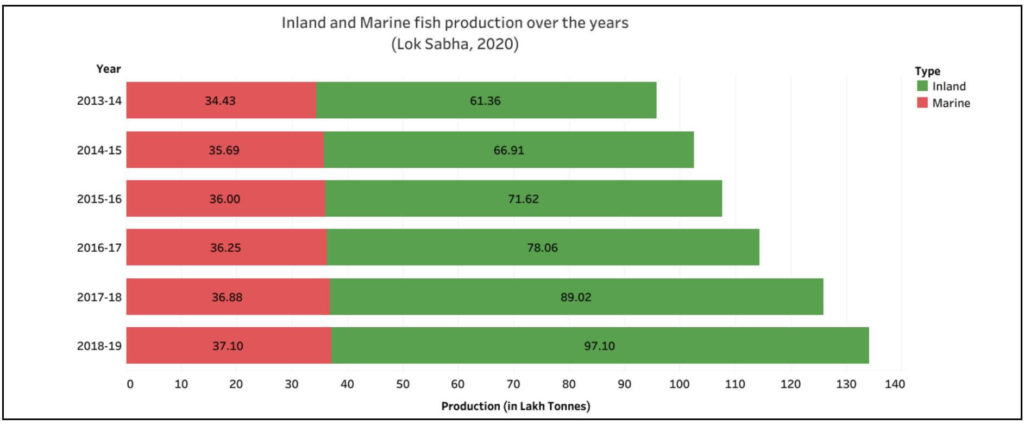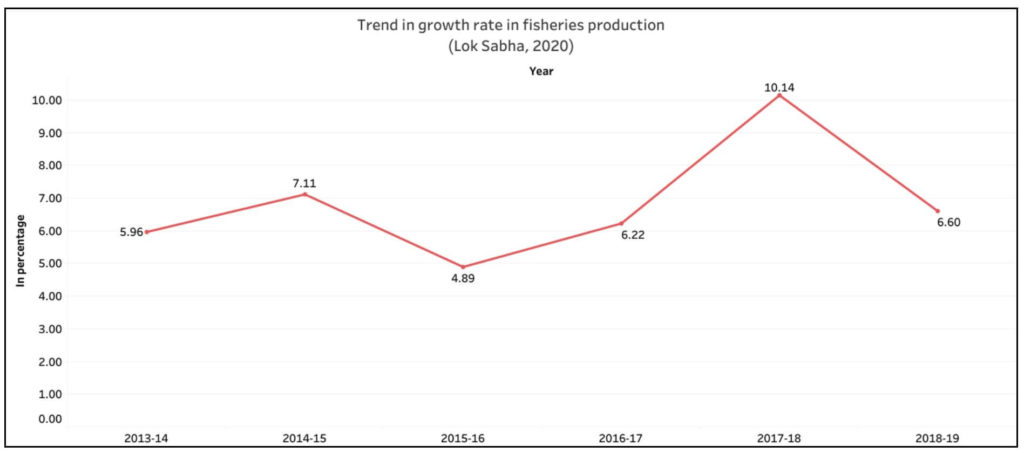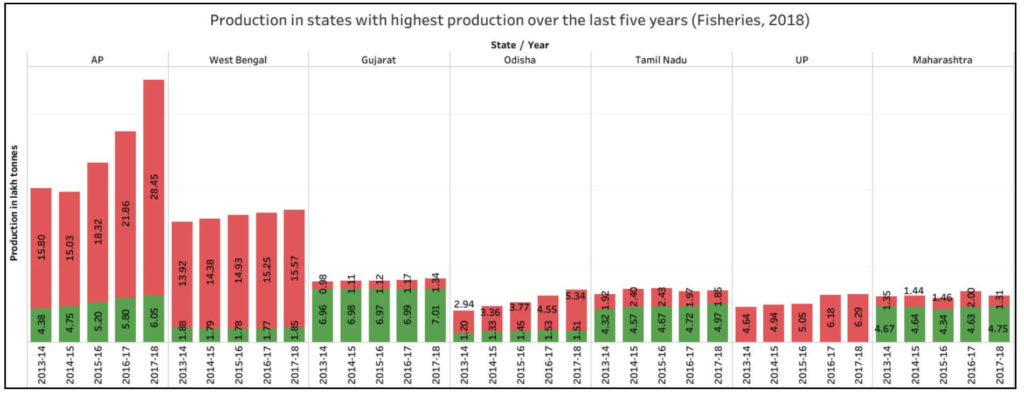Through the Atmanirbhar package, the government announced schemes for various sectors. One of these is the ‘Pradhan Mantri Matsya Sampada Yojana (PMMSY)’ through which the government aims to increase the fish production to 20 million tonnes by 2022-23 which currently stands at 13.4 million tonnes in 2018-19. To reach the government’s target by 2022-23, the current annual average growth rate needs to double.
Indian peninsula is home to millions of people who are dependent on fisheries for their livelihood. Besides being a source of livelihood to millions, the sector contributes immensely to food production, employment generation, and earning foreign exchange. Over the last few years, the industry has made rapid strides. It is an inexpensive source of nutritious food and like the agricultural sector, fisheries sector too has traditionally been a contributor to socio-economic development of the country.
COVID-19, which has left no sector untouched, has affected the fisheries sector too, and as a part of the Atmanirbhar package, the Central Government has announced a new scheme by name ‘Pradhan Mantri Matsya Sampada Yojana (PMMSY)’ with the objective to bring about ‘integrated, sustainable, inclusive development of marine and inland fisheries.’ This scheme was originally announced in the 2019-20 budget.
Department of fisheries was created in 2019
A separate ministerial portfolio, Ministry of Fisheries, Animal Husbandry, and Dairying was created in 2019 by the central government, with two separate departments- department of fisheries and department of animal husbandry & dairying to focus on livestock and fisheries in the country. The main role of the department is promotion of policies and strategies aimed at the sustainable and responsible development of fisheries and aquaculture in both inland and marine waters. Inland fisheries and aquaculture are the main components of the fisheries sector in India whose production is more than twice that in marine fisheries. The geographical diversity in India is also ideal for both marine and inland fisheries, thereby making it one of the lead producers of fish globally. India’s coastline extends over 8,118 kilometres with an Exclusive Economic Zone of 2.02 million square kilometres. The total area covered by inland water bodies is 73.59 Lakh hectares, almost two times the size of the state of Kerala.
As per available government data, the contribution of fisheries to Gross Value Added (GVA) is ₹ 1,33,492 crores in 2016-17, which is around 1% of the GVA. The export value of fisheries in 2017-18 was ₹ 45,106 crores. Fish production stood at 13.4 million tonnes in 2018-19.

Mission blue revolution is an umbrella scheme that brings together different existing schemes in the sector to boost production and extend financial support
Recently, the government announced Pradhan Mantri Matsya Sampada Yojana as a part of the Atmanirbhar package. Even before this, the central government has been implementing various schemes and allocating funds for the development of the sector. A centrally sponsored scheme was rolled out in 2015 for five years (up to 2019-20), by the NDA Government by merging all the ongoing schemes under an umbrella known as Blue Revolution: Integrated Development and Management of Fisheries. Through Mission Blue Revolution, the government plans to focus on enhancing fish productivity, by increasing fish production at a growth rate of 6% to 8% and create necessary infrastructure. The major components of the umbrella scheme include:
- Development of inland fisheries and aquaculture
- Development of marine fisheries- infrastructure and post-harvest
- National Scheme for Welfare of Fishermen
- Monitoring, Control and Surveillance of need based interventions
- Institutional Arrangement for Fisheries Sector
- Strengthening of Database and Geographical Information System
- National Fisheries Development Board and its activities

Target of 20 million tonnes by 2022-23
In October 2018, the government launched the Fisheries and Aquaculture Infrastructure Development Fund (FIDF) to meet the infrastructural requirements in the sector. The target set was to produce 15 million tonnes by 2020 by supporting Blue Revolution. FIDF also aims to achieve a sustainable growth of 8% to 9% to increase India’s fish production to 20 million tonnes by 2022-23. Under FIDF, a corpus of ₹10,000 crores was announced in the Union Budget in 2018. An estimated fund size of Rs 7522.48 crore comprising of Rs 5266.40 crore was to be raised by the Nodal Loaning Entities (NLEs), Rs 1316.6 crore through beneficiaries’ contribution and Rs 939.48 crore budgetary support from Government of India. Furthermore, the government also extended the facility of Kisan Credit Card to fisherfolk for meeting their short-term working capital requirements.
Overall fish production increased by over 38% in six years
In the last six years, both inland and marine fish production has witnessed an increase, resulting in a net increase in the total fish production. Inland fishes contribute to almost two-thirds of the net fish production in the country. While the marine fish production in India increased by 7.75% in the span of six years, the inland fish production increased by 58.2%. The data for 2018-19 is provisional, according to Lok Sabha answer given in February 2020. The overall fish production increased by around 38.5% in these six years.

Annual average growth rate is only 6.8%
Though the government has aimed at a stable increase of around 8% in annual fish production, under blue revolution mission, the average annual growth rate stands at 6.8% for the last six years. The annual growth dropped to below 5% in 2015-16 and touched the highest of 10.2% in 2017-18. If we are to reach the target of 20 million tonnes of fish production by 2022-23, the current annual average growth rate needs to double to around 13.2% per year.

Andhra Pradesh accounts for more than a quarter of India’s fish production in 2017-18
State wise data in 2017-18 shows that the best performing states in terms of fish production are Andhra Pradesh, West Bengal, Gujarat, Odisha, Tamil Nadu, Uttar Pradesh and Maharashtra, in the same order. There has been a continuous increase in fish production over the past five years from 2013-14 to 2017-18, in each of these states. Even though the production is second highest in West Bengal, the production is almost half of that in Andhra Pradesh which accounts for the largest production in India. Andhra Pradesh accounted for 27% of the fish production in India in 2017-18. Odisha overtook Tamil Nadu in production only in 2017-18. Production in Andhra Pradesh and Odisha have increased by 71% and 65% over the six-year period, the highest percentage increase among the states that have been compared here

PMMSY was announced in the 2019-20 budget speech
Finance Minister had proposed the Pradhan Mantri Matsya Sampada Yojana (PMMSY) scheme in her union budget for 2019-20. It was later announced in the Atmanirbhar package and approved by the cabinet. Through this scheme, the government aims to harness the potential of fisheries in the country in a sustainable, responsible, inclusive, and equitable manner. Like in the case of agricultural sector, this new scheme is aimed at doubling fishers’ and fish farmers’ income, as per government’s scheme information. This scheme is claimed to be the highest investment in fisheries sector by a government at ₹ 20,050 crores. The Central share is ₹ 9407 crores while state’s share is ₹ 4880 crore and Beneficiaries contribution is ₹ 5763 crores. The scheme was brought about to address the critical gaps in fish production and productivity, quality, technology, post- harvest infrastructure and management, modernization of the sector, and also for the welfare of the fishers.
It is also an umbrella scheme with two components
PMMSY has two components- Central Sector Scheme and Centrally Sponsored Scheme. Under the Central Sector Component, an amount of ₹1,720 is earmarked while under the Centrally Sponsored Scheme, an amount of ₹18,330 crores has been envisaged- which is further segregated into non-beneficiary oriented and beneficiary oriented activities grouped under three categories- (i)for enhancing production and productivity, (ii) infrastructure and post- harvest management, and (iii) fisheries management and regulatory framework. The scheme will be implemented over five years from 2020-21 to 2024-25.
While the PMMSY might be able to augment infrastructure and provide the much-needed funding, achieving the target of 20 million tonnes by 2022-23 seems like a tall order.
Featured Image: Pradhan Mantri Matsya Sampada Yojana


